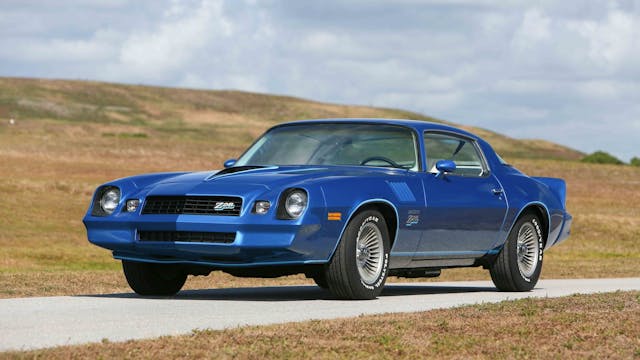Media | Articles
Which Camaro should you buy, sell, or hold?
Want a better understanding of what’s driving collector-car values? Sign up for the Hagerty Insider newsletter.
There’s an implied truth to the Chevy Camaro that applies to any example across its six generations. An honesty about what it is, along with just a touch of “I-can-back-up-my-looks” self-assuredness, endears the Camaro to legions. As new cars, Camaros have always offered an excellent performance entry point. As collector cars, most models still represent affordable fun from eras gone by. We’ve noticed some value trends lately across a few of the Camaro’s generations, so we decided to share from the perspective of cars you should buy, sell or, hold.
The Gold Standard of Camaros—the first generation—escapes judgment here. And while two the most recent generations offer a mix of old values and new technology, their positions on the late-model depreciation curve make data a bit too murky. Let’s see where the other three generations of Camaro fit in our assessment.
Buy: 4th gen SS and Z/28

The T-top F-body at its most evolved, the fourth-gen Camaro offers a unique middle ground: modern power and ’90s styling with quintessential Camaro character. The distinctive hood scoop, rear wing, and extra performance goodies added by SLP engineering help the SS stand out further.
“They represent good value for the performance, especially later cars with the LS1,” notes Hagerty Price Guide editor Greg Ingold.
Marketplace
Buy and sell classics with confidence
Values for the Camaro SS in #2 and #3 condition stayed fairly flat for years, but like many vehicles they saw a pandemic bump in early 2021. There’s definite room for growth still, and it’s not just because an LS1 engine and available T-56 six speed manual are a blast to drive. The fourth-gen SS and Z/28 in particular feel a bit ahead of the curve; they have yet to take off in value like third-gen IROC-Zs, and 1990s performance cars continue to rise in popularity.
“I don’t see a world in which these don’t keep going,” said Ingold.
Sell: Late 2nd-gen Z/28 (1978–81)

The Z/28s from the end of the second generation have experienced a heroic upward trajectory, likely thanks to a substitution effect related to the Bandit Trans Am’s exploding value. There are only so many flashy Pontiac F-bodies from the Malaise Era to go around, after all. Though the Z/28 made do with a 350-cubic inch engine instead of the 400 (or Olds 403 in automatic-equipped models) found in the Trans Am, that difference matters less these days than it did in period. V-8 rumble, aggressive looks, and assertive stickers make the Z stand out regardless of displacement.
Values in the last few years reflect the late ’70s Z/28’s increased popularity. 2023 has seen a noticeable downturn, however—a result of several months of mixed public sales. “Often, vehicles that appreciate this rapidly are among the first to reset values as part of a market correction,” notes Ingold.
That in and of itself is not a reason to unload—you did buy your collector car to enjoy it, right? Just the same, the market has softened on these, and if you are considering selling, now be the best time to maximize your return on your F-body investment rather than waiting toward the end of this year’s driving season.
Hold: 3rd-gen IROC-Z and Z/28

The third-gen IROC and Z/28 Camaros are represent a more stable play from a valuation perspective. After a healthy 50+ percent increase for #2 Condition cars over the last few years, values have settled somewhat. The 305-cubic inch examples have taken a 5 percent loss recently, but IROC values are strong when equipped with the iconic 350-cu-in powerplant. These don’t benefit from a substitution effect—the third gens are sought after for what they are.
“Third-gens are still relatively affordable in comparison to other generations of Camaro,” said Ingold. “Given their age, and the fact that Gen-X and older Millennials are steadily growing as the dominant force in the collector market, there is still potential for these to go up.”
We’ve made our choices, but which Camaro would you add to your stable? Which would you unload? Which would you keep? Let us know in the comments.
***
Check out the Hagerty Media homepage so you don’t miss a single story, or better yet, bookmark it. To get our best stories delivered right to your inbox, subscribe to our newsletters.
Via Hagerty Insider












Wish I still had my 1973 Rally Sport Camaro. Metallic Forest Green. Last year for the Split bumper, Enduro nose and Bullet Tail lights. That car was awesome.
As stated in the introductory text “The Gold Standard of Camaros—the first generation—escapes judgment here.” I don’t think anyone can disagree, they are beautiful collectible cars. Prices on them today dictate that they are limited in availability to many collectors and enthusiasts. I enjoy my 78 Z28, my first car was a 75 (40 years ago) so there’s an emotional rush to owning the 78 today at 56 years old. I just picked up a clean low mileage 95 Z28 as more of a regular driver, and at their current price point, there are many smiles per miles to be had. Given their relatively low market price and emerging market demographics, I can understand the authors stance as a “buy”.
2011 Neaman Marcus Christmas Catalogue Special Edition #74 of 75 made (originally they were going to make 100), Convertible Camaro 10k Miles, Garage/Carport kept, Excl Cond.
Sell?
Appreciate any replies.